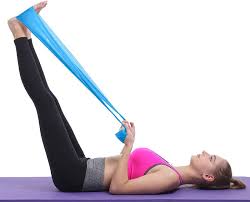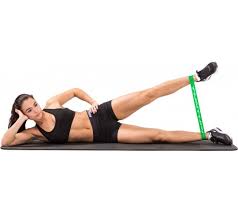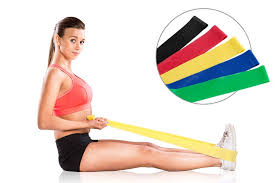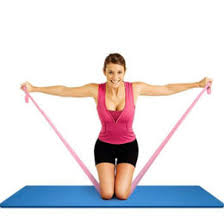2021-01-31
From elliptical trainers to weight lifting equipment to gyms, you can choose the right fitness equipment. If you are looking for a portable and affordable alternative, using resistance bands for strength training is a good choice. After all, large fitness equipment cannot be carried with you when traveling, and may not fit in your house. Then you can first consider resistance bands that are lightweight and easy to move.

Resistance bands have caused a fitness trend. Fitness people use them to lose weight, practice coordination, etc. and can be used for professional fitness and bodybuilding. Generally, the length of the exercise bands needs to be 1.8 meters. This length can maximize the development of the training of the whole body muscles. The principle of use is to exercise the physique by using the gravity during pulling and form resistance to the muscles that exert force. The user achieves the purpose of training muscles by resisting resistance and contracting muscles. Compared with the traditional fitness method, this process enhances the fun of exercise, facilitates the carrying of equipment, changes the method of exerting force, and can improve the quality of training to a greater extent.

Action 1: Resistance bands push-ups
If your chest, triceps, and shoulders are already strong, face the challenge of adding resistance bands to push-ups: Assume that the push-up position is balanced on your hands and toes and your body is straight from head to toe.
Hang the resistance band over your shoulders so that both ends are exposed under your armpits, and then firmly fix both ends under your hands.
Bend your arms, lower yourself to the "down" position of the push-up, and then adjust the straps under your wrists so that the tension in that position is moderate. Just getting the belt tension right is an exercise in itself.
Straighten your arms to press back into the "up" position of the push-ups and resist the resistance of the band. This completes a repetition.
Action 2: Resistance bands chest compression
To exercise the main pushing muscles of the chest, triceps and shoulders, consider using a resistance band to simulate chest compressions: wrap the strap around your back, just below your shoulder height. Each end of the band should reach one armpit.
Grasp one end of the strap with both hands, bend your arms, and raise your elbow to the side below your shoulders. Keep your hands straight in front of your elbows and adjust your grip until the tension on the wristband is moderate.
Straighten your arms and straighten your hands forward; your straight arms should be placed directly in front of your shoulders.
Bend your arm and return to the starting position in a smooth, controlled motion.

Action 1: Static stabbing
Not all lunges changes can have a good effect on the elastic resistance bands, but static lunges may be very effective and will target every muscle in your lower body. In other words, you should practice the sprint form without resistance bands first, and only add resistance bands when you are confident in your form and ready for additional challenges.
Hold one end of the resistance bands with two hands, and then use one foot to firmly fix the midpoint of the resistance band to the floor.
Step back with your free legs and bend your knees to lower the lunge position.
Check your shape: your back knees should be below your hips, and your front knees should be above your toes instead of extending your toes forward.
Bend your elbows and raise your hands to your shoulders. Adjust your grip on the resistance band suntil you apply moderate tension to this position (the "down" position of the lunge).
Push your hands apart to stand upright again, and raise your back foot to meet the other foot. Keep your elbows bent and place your hands on the front of your shoulders to maintain tension on the wristband.
Back with the same leg, bend your knees again, put it back into the lunge, and complete a repetition.
As always, when you do such a unilateral exercise, remember to switch your legs and do a full workout on the other side.
Action 2: Squat with resistance bands
Squats are almost perfect lower body exercises. If you are just getting started, you can trim the squat without any additional resistance. Once you are ready for the bigger challenge, it's time to add resistance bands.
When standing, the width of the feet is slightly wider than the width of the hips, and then the middle part of the resistance band is firmly fixed under the feet.
Hold one end of the resistance bands with both hands. Stretch your hands straight down to the sides.
Sink to squat-hips back, chest up, and flat back, then adjust the grip on the belt until there is slight tension in the "down" position.
Stand up against the resistance of the band, then sink into the "down" position to complete a repetition.

Action 1: Sitting in row
You can also use the elastic resistance bands to row and sit, which can also exercise the pulling muscles of the back and arms. Sit on the floor, on a yoga mat, or even on the bed. Any comfortable, flat surface will do.
Straighten your legs in front of you, and then wrap the exercise bands around your feet. Make sure the strap is completely secure. If you are not flexible enough to fully straighten your legs and sit upright, you can bend your legs slightly at your knees.
Sit up straight and stretch your arms forward, grab both ends of the resistance bands with one hand. When you straighten your arm, the wristband should have a slight tension.
Pull both ends of the strap back toward the belly button, bringing your hands and elbows close to your body.
Stop when the elbow breaks the plane of the torso, and then return to the starting position in a controlled motion.
Action 2: Elastic pull-down
The elastic pull-down device can exercise all the main pulling muscles of the back and arms.
Hold both ends of the elastic resistance bands with one hand. Use a foam anchor to fix the midpoint of the strap above the top of the door, or tie a knot at the midpoint of the strap, and then tie the knot to the top of the doorway.
Kneeling and facing the door, keep your chest up and out, and stretch your arms up. Adjust your grip so that there is a slight tension on the elastic when you stretch your arms.
Pull your arm down and let your elbow guide you forward. Release slowly back to the starting position to complete the repeat.

Welcome to contact us for exercise bands, FITOP will provide you with high-quality products. If you have any ideas or suggestions to do resistance bands work, you can also contact us.
Request a Quote
Request a Quote